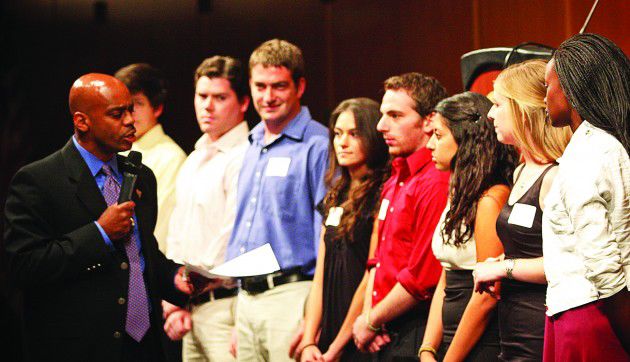Student Leadership Dinner promotes collaboration among organizations
September 22, 2010
About 175 students and 20 administrators talked student-leadership over a cocktail hour and buffet dinner hosted by SGA and the Office of the President in the Villanova Room on Monday night.
The occasion was the Student Leadership Dinner, a kickoff event that sets the tone for all organizations for the year, according to senior and Student Body Vice President Allison Webb.
“It’s supposed to be a celebration –– the leaders should be proud to have gotten to where they are,” said senior and Student Liason of SGA Meghan Williams, who organized what has morphed into a large-scale dinner over the past two years. “It’s also a challenge: a challenge to all the leaders, to motivate them to leave a lasting impact on the Villanova community.”
SGA also endeavored to encourage collaboration among student groups by providing an opportunity for them to meet and potentially collaborate, according to Williams.
“The first hour was designed as a cocktail hour to facilitate mingling among the leaders of organizations as well as the administrators in attendance,” she said. “Seating was also assigned to ensure that more than one group sat at a table, in addition to at least one administrator and an SGA rep.”
During the dinner, select student-leaders and administrators spoke, including the guest of honor, University President Rev. Peter Donohue, O.S.A., and political science professor Frank Pryor.
Pryor, who delivered the keynote address, engaged the audience by bringing eight student-leaders up to the podium with him and energized all in attendance to “T.H.I.N.K. B.I.G.,” an acronym meaning talent, honesty, insight, nice, knowledge, books, in-depth knowledge and God.
For the student-spokesperson, SGA did not select one of its most involved members, but rather, former Co-Chair of External Affairs for SGA Larry Zuccato, a junior who actually stepped down last year.
“He left because he wanted to dedicate his whole self to the organizations he was a part of,” Halligan said of Zuccato, who is currently vice president of Phi Sigma Kappa, and involved at an executive level with Special Olympics and Order of Omega. Like countless other eager first-year students, Zuccato approached his first activities fair as a “maze to build a résumé” and admits that he must have signed up for 50 organizations.
“I finally realize what it means to spread myself too thin,” Zuccato said to the audience.
The confession marked SGA’s acknowledgement of the phenomenon of students focusing on quantity over quality in their extracurricular endeavors –– and an effort to encourage people to pursue what they are passionate about in order to be able to dedicate more of themselves to the organization and, ultimately, make more of a lasting impact on the Villanova community, according to Williams.
“The message this year wasn’t to approach getting involved at Villanova by joining a million clubs, but rather, to avoid spreading yourself too thin by focusing on clubs you truly have a passion for,” he said.
Williams was moved by the campaign platform of Durrant/Murphy, an SGA ticket last year that called attention to what they dubbed the “Big 4,” a moniker denoting expansive clubs such as SGA itself, Blue Key and Orientation Committee.
“It seems like there are a handful of clubs that receive the most notice,” she said. “I want to give all clubs a voice with this dinner.”
But Halligan adds that the voices of each club should not be competing voices.
“It should not be a competition between groups,” she said. “We can get more done and make more of an impact by focusing on collaboration rather than competition.”
To initiate planning, Williams, who began organizing the event when she was appointed to her current position and booked the venue in late April, built on last year’s student leadership directory with senior Ed Phillips. Phillips created this year’s booklet of all student organizations and the contact information for their leaders.
“The University currently doesn’t offer anything similar, at least not available to all students,” Williams said.
This year, SGA expanded Phillips’ efforts to make the list more comprehensive, contacting last year’s leaders to update the information for their organization, though not all organizations responded, according to Williams.
Still, of the 250 groups invited, 170 attended, marking record attendance, according to Halligan.
Copies of the directory were distributed to guests at the end of the dinner, along with folders that were provided by the Career Center, whose presence at the event marked the center’s efforts to call attention to itself as a resource for students, according to Williams.
“The evening represented our ongoing efforts to reach across all corners of campus,” Halligan said. “We look forward, for example, to working with the Office of Disability Services.”
Donohue, who spoke during the dinner, described leadership as a constant learning experience.
“I keep on learning,” Halligan said.











